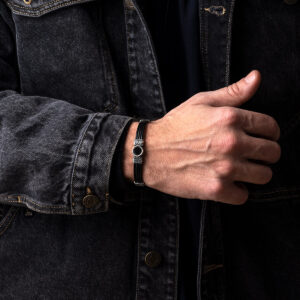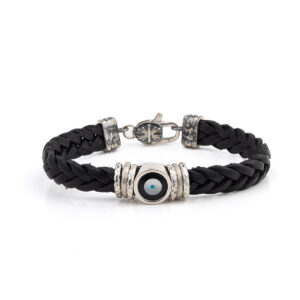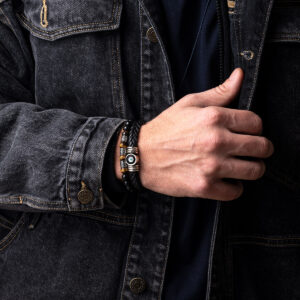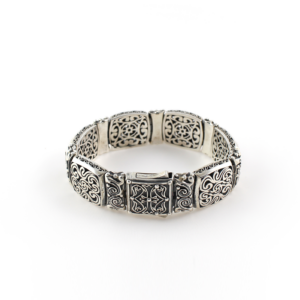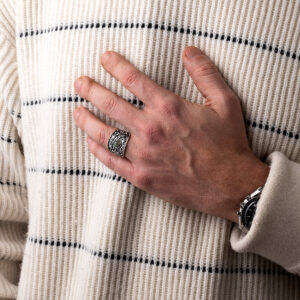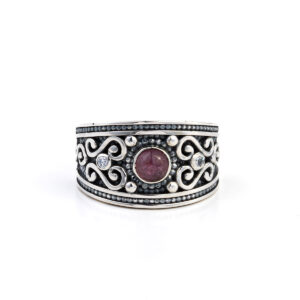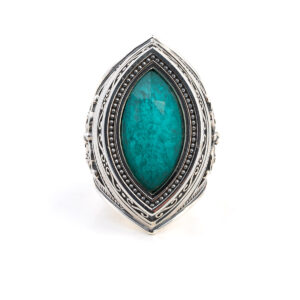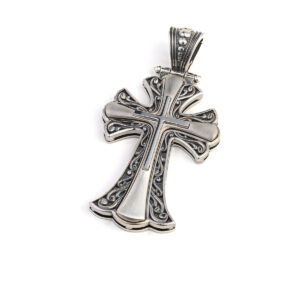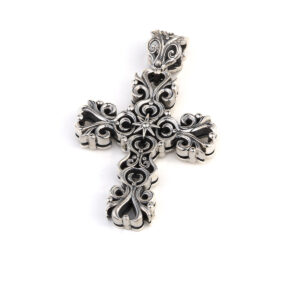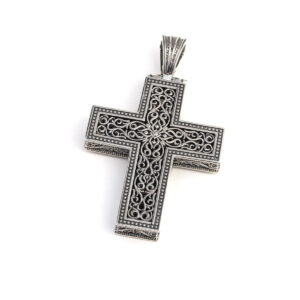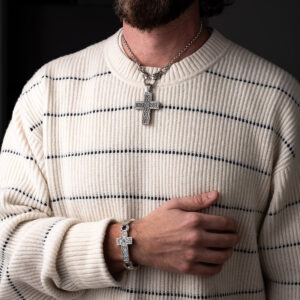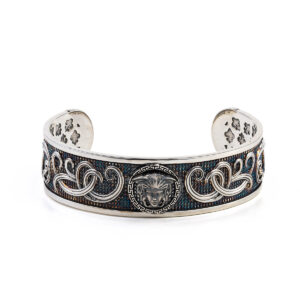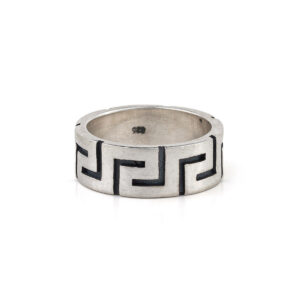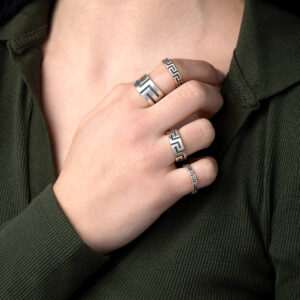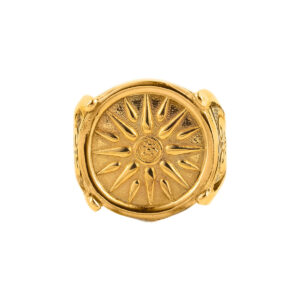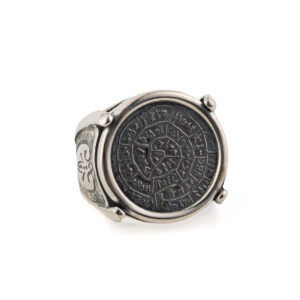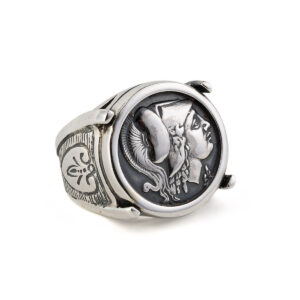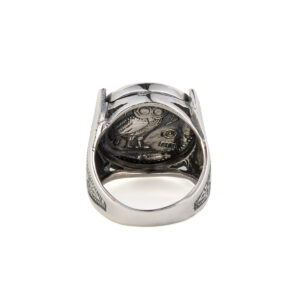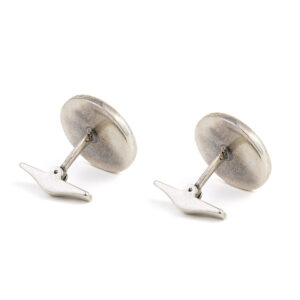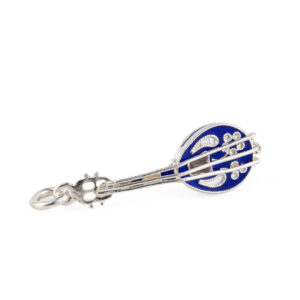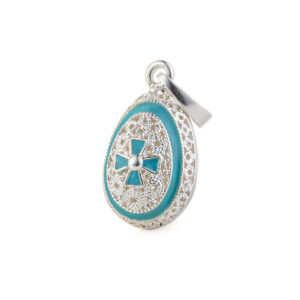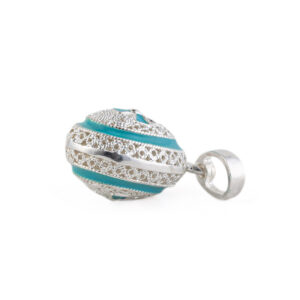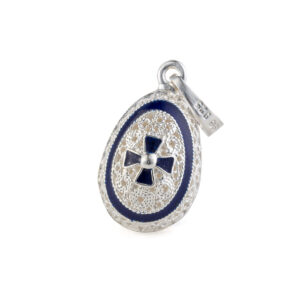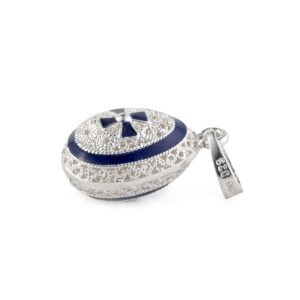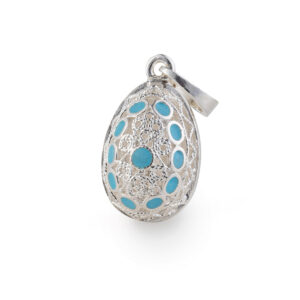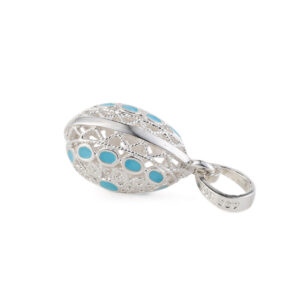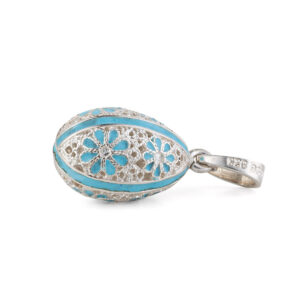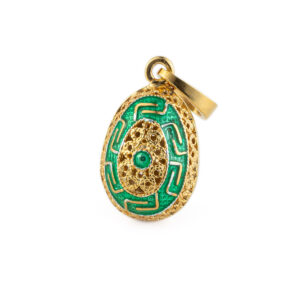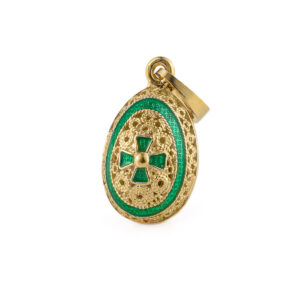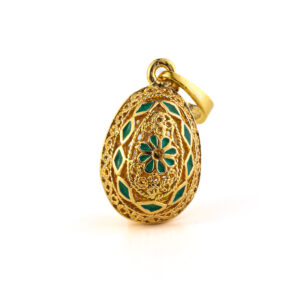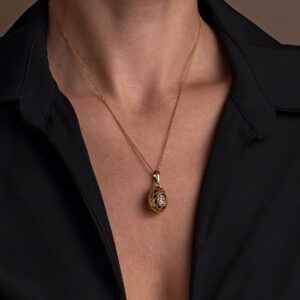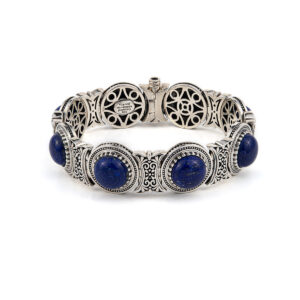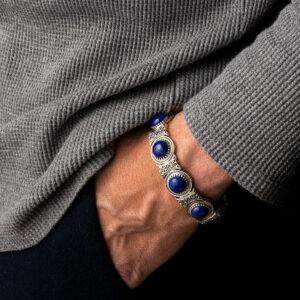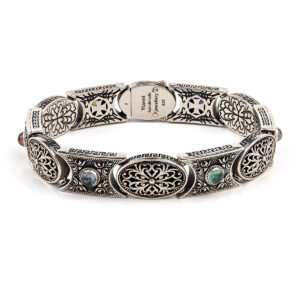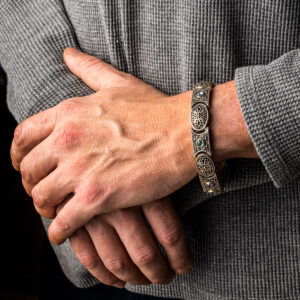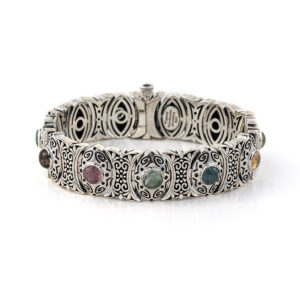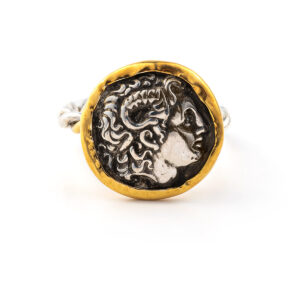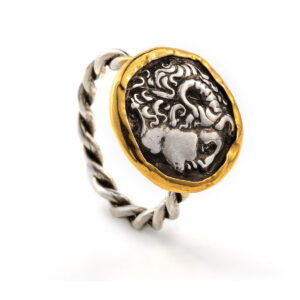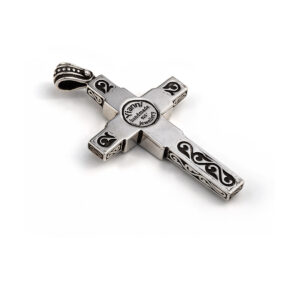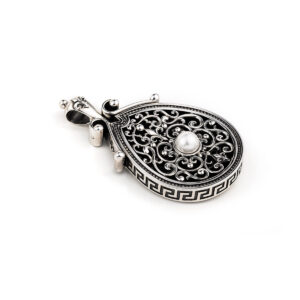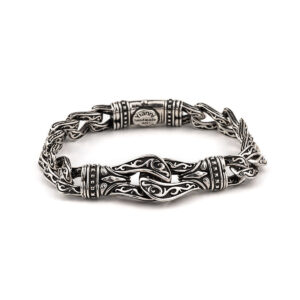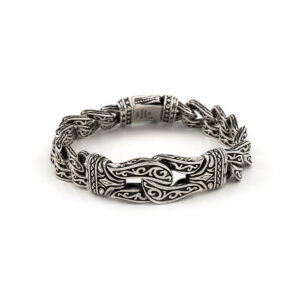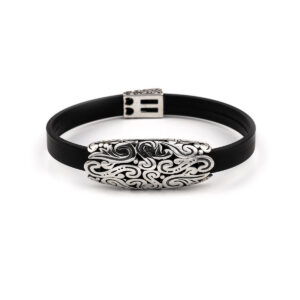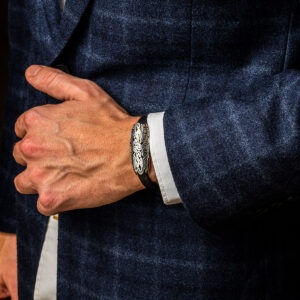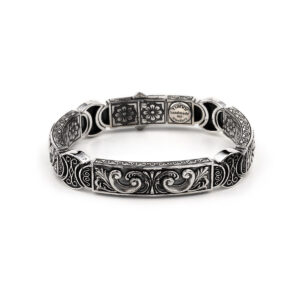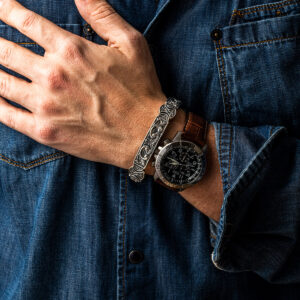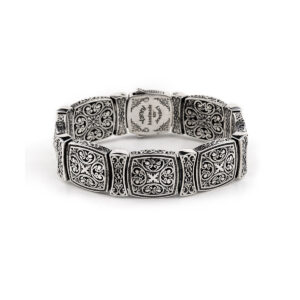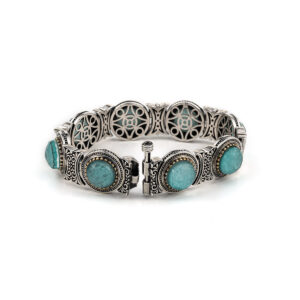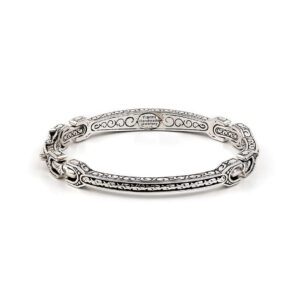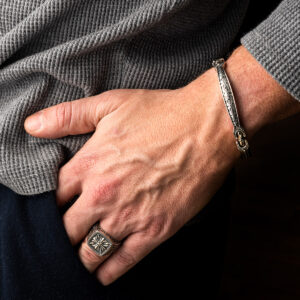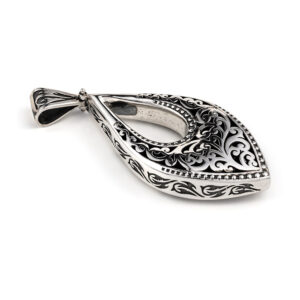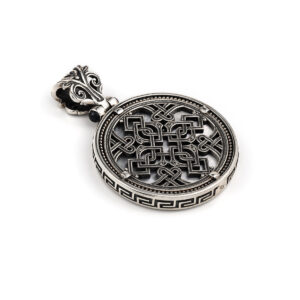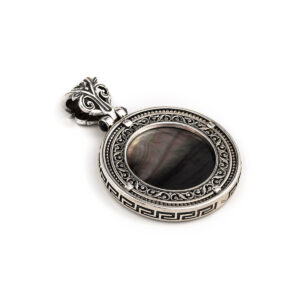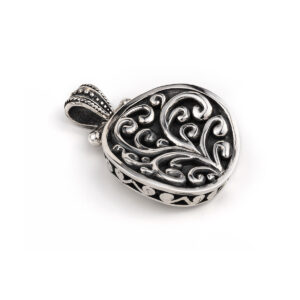Δερμάτινο Βραχιόλι με Όνυχα – Ασήμι 925
Κατασκευασμένο από ασήμι 925 και λουράκι από δέρμα.
Το βραχιόλι μπορεί να κατασκευαστεί σε οποιοδήποτε επιθυμητό μήκος (μικρότερο ή μεγαλύτερο). Παρακαλώ εισάγετε το μήκος που θέλετε στη σημείωση του αγοραστή.
Χειροποίητο ελληνικό κόσμημα.
Δερμάτινο βραχιόλι με Μάτι και Μαίανδρο – Ασήμι 925
198,00€Κατασκευασμένο από ασήμι 925 και λουράκι από δέρμα.
Το βραχιόλι μπορεί να κατασκευαστεί σε οποιοδήποτε επιθυμητό μήκος (μικρότερο ή μεγαλύτερο). Παρακαλώ εισάγετε το μήκος που θέλετε στη σημείωση του αγοραστή.
Χειροποίητο ελληνικό κόσμημα.
Δερμάτινο Βραχιόλι με Μάτι – Ασήμι 925
Κατασκευασμένο από ασήμι 925 και λουράκι από δέρμα.
Το βραχιόλι μπορεί να κατασκευαστεί σε οποιοδήποτε επιθυμητό μήκος (μικρότερο ή μεγαλύτερο). Παρακαλώ εισάγετε το μήκος που θέλετε στη σημείωση του αγοραστή.
Χειροποίητο ελληνικό κόσμημα.
Μενταγιόν Φαιστός – 14Κ Χρυσό
258,00€ – 1.069,00€Κατασκευασμένο από 14Κ χρυσό.
Ο Δίσκος της Φαιστού είναι ένας δίσκος από πηλό από το μινωικό παλάτι της Φαιστού στο νησί της Κρήτης. Τώρα, το νησί της Κρήτης είναι μέρος της σύγχρονης Ελλάδας. Ο δίσκος ανακαλύφθηκε το 1908 από τον Ιταλό αρχαιολόγο Luigi Pernier στο μινωικό παλάτι της Φαιστού. Ακόμα και στις μέρες μας η αποκρυπτογράφηση του δεν είναι ξεκάθαρη, καθιστώντας το ένα από τα πιο διάσημα μυστήρια της αρχαιολογίας. Ο δίσκος έχει διάμετρο περίπου 15 εκατοστά και καλύπτεται και στις δύο πλευρές με μια σπείρα από σφραγισμένα σύμβολα. Ο δίσκος διαθέτει 241 μάρκες, που περιλαμβάνουν 45 ξεχωριστά σημάδια, τα οποία φτιάχτηκαν προφανώς πιέζοντας ιερογλυφικές «σφραγίδες» σε ένα δίσκο από μαλακό πηλό, με μια δεξιόστροφη ακολουθία που στρέφεται προς το κέντρο του δίσκου. Αυτό το μοναδικό αντικείμενο εκτίθεται τώρα στο αρχαιολογικό μουσείο Ηρακλείου.
Χειροποίητο ελληνικό κόσμημα.
Βραχιόλι Λαβύρινθος – Ασήμι 925 Yianni
Κατασκευασμένο από ασήμι 925.
Χειροποίητο ελληνικό κόσμημα.
Αυτές οι ασημένιες δημιουργίες των κοσμημάτων Yianni, δημιουργήθηκαν από τον Garbis Khacherian, έμπορο αργυροχοΐας από το 1987.
Ανακαλύψτε τη συλλογή Yianni
Βυζαντινό Δαχτυλίδι με Τουρμαλίνη – Ασήμι 925
Κατασκευασμένο από ασήμι 925.
Χειροποίητο ελληνικό κόσμημα.
Αυτές οι ασημένιες δημιουργίες των κοσμημάτων Yianni, δημιουργήθηκαν από τον Garbis Khacherian, έμπορο αργυροχοΐας από το 1987.
Ανακαλύψτε τη συλλογή Yianni
Βυζαντινό Δαχτυλίδι με Ροζ Τουρμαλίνη – Ασήμι 925
Κατασκευασμένο από ασήμι 925.
Χειροποίητο ελληνικό κόσμημα.
Αυτές οι ασημένιες δημιουργίες των κοσμημάτων Yianni, δημιουργήθηκαν από τον Garbis Khacherian, έμπορο αργυροχοΐας από το 1987.
Ανακαλύψτε τη συλλογή Yianni
Βυζαντινό Δαχτυλίδι Μαλαχίτης – Ασήμι 925
Κατασκευασμένο από ασήμι 925.
Χειροποίητο ελληνικό κόσμημα.
Αυτές οι ασημένιες δημιουργίες των κοσμημάτων Yianni, δημιουργήθηκαν από τον Garbis Khacherian, έμπορο αργυροχοΐας από το 1987.
Ανακαλύψτε τη συλλογή Yianni
Βυζαντινός Σταυρός Μενταγιόν – Ασήμι 925
Κατασκευασμένο από ασήμι 925.
Χειροποίητο ελληνικό κόσμημα.
Αυτές οι ασημένιες δημιουργίες των κοσμημάτων Yianni, δημιουργήθηκαν από τον Garbis Khacherian, έμπορο αργυροχοΐας από το 1987.
Ανακαλύψτε τη συλλογή Yianni
Σταυρός Μενταγιόν Odin – Ασήμι 925
Κατασκευασμένο από ασήμι 925.
Χειροποίητο ελληνικό κόσμημα.
Αυτές οι ασημένιες δημιουργίες των κοσμημάτων Yianni, δημιουργήθηκαν από τον Garbis Khacherian, έμπορο αργυροχοΐας από το 1987.
Ανακαλύψτε τη συλλογή Yianni
Βυζαντινός Ορθόδοξος Σταυρός – Ασήμι 925
Κατασκευασμένο από ασήμι 925.
Χειροποίητο ελληνικό κόσμημα.
Αυτές οι ασημένιες δημιουργίες των κοσμημάτων Yianni, δημιουργήθηκαν από τον Garbis Khacherian, έμπορο αργυροχοΐας από το 1987.
Ανακαλύψτε τη συλλογή Yianni
Βυζαντινό βραχιόλι Mother of Pearl – Ασήμι
Κατασκευασμένο από ασήμι 925.
Χειροποίητο ελληνικό κόσμημα.
Αυτές οι ασημένιες δημιουργίες των κοσμημάτων Yianni, δημιουργήθηκαν από τον Garbis Khacherian, έμπορο αργυροχοΐας από το 1987.
Ανακαλύψτε τη συλλογή Yianni
Χειροποίητο Βραχιόλι Μέδουσα – Ασήμι 925
Κατασκευασμένο από ασήμι 925.
Χειροποίητο ελληνικό κόσμημα.
Αυτές οι ασημένιες δημιουργίες των κοσμημάτων Yianni, δημιουργήθηκαν από τον Garbis Khacherian, έμπορο αργυροχοΐας από το 1987.
Ανακαλύψτε τη συλλογή Yianni
Μαίανδρος Δαχτυλίδι – 925 Ασήμι
Δαχτυλίδι με τον Ήλιο της Βεργίνας – Ασήμι και επιχρυσωμένo
Φτιαγμένο από ασήμι 925 επιχρυσωμένο.
Χειροποίητο Ελληνικό Κόσμημα
Ανακαλύψτε τη συλλογή Κληρονομιά
Ιστορία
Ο Ήλιος της Βεργίνας είναι ένα αρχαίο ελληνικό σύμβολο που απεικονίζεται σε διάφορα αρχαιολογικά ευρήματα, όπως αγγεία και νομίσματα, αλλά έγινε ευρέως γνωστό λόγω της απεικόνισης του στη χρυσή λάρνακα που βρέθηκε το 1977 σε Βασιλικό τάφο ο οποίος αποδίδεται στη Μακεδονική Βασιλική Δυναστεία του Φιλίππου Β΄ και του Μεγάλου Αλεξάνδρου.
Δαχτυλίδι Δίσκος της Φαιστού – Ασήμι 925
Αυτό το όμορφο δαχτυλίδι αναπαριστά το δίσκο της Φαιστού.
Χειροποίητο ελληνικό κόσμημα.
Κατασκευασμένο από ασήμι 925°.
Ο Δίσκος της Φαιστού είναι ένας δίσκος από πηλό από το μινωικό παλάτι της Φαιστού στο νησί της Κρήτης. Τώρα, το νησί της Κρήτης είναι μέρος της σύγχρονης Ελλάδας. Ο δίσκος ανακαλύφθηκε το 1908 από τον Ιταλό αρχαιολόγο Luigi Pernier στο μινωικό παλάτι της Φαιστού. Ακόμα και στις μέρες μας η αποκρυπτογράφηση του δεν είναι ξεκάθαρη, καθιστώντας το ένα από τα πιο διάσημα μυστήρια της αρχαιολογίας. Ο δίσκος έχει διάμετρο περίπου 15 εκατοστά και καλύπτεται και στις δύο πλευρές με μια σπείρα από σφραγισμένα σύμβολα. Ο δίσκος διαθέτει 241 μάρκες, που περιλαμβάνουν 45 ξεχωριστά σημάδια, τα οποία φτιάχτηκαν προφανώς πιέζοντας ιερογλυφικές «σφραγίδες» σε ένα δίσκο από μαλακό πηλό, με μια δεξιόστροφη ακολουθία που στρέφεται προς το κέντρο του δίσκου. Αυτό το μοναδικό αντικείμενο εκτίθεται τώρα στο αρχαιολογικό μουσείο Ηρακλείου.
Δαχτυλίδι με Νόμισμα Αθηνάς Χαλινίτη – Ασήμι 925
Αυτό το αρχαιοελληνικό νόμισμα αναπαριστά την Αθηνά Χαλινίτη.
Κατασκευασμένο από ασήμι 925.
Χειροποίητο ελληνικό κόσμημα.
Αθηνά – Στατήρας της Κορίνθου
Αυτός ο αργυρός στατήρας της Κορίνθου απεικονίζει την κεφαλή της Αθηνάς Χαλινίτη.
Μανικετόκουμπα Αθηνά – Ασήμι 925
This coin is one of the most popular ancient Greek coins which illustrate the portrait of Goddess Athena.
Made in house in 925⁰ sterling silver and gold plated.
Goddess Athena and Owl – Athenian silver tetradrachm
Dracma was the currency used in Greece during several periods in its history.
The tetradrachm was an Ancient Greek silver coin equivalent to fourdrachmae in Athens it replaced the earlier “heraldic” type of didrachms and it was in wide circulation from ca. 510 to ca. 38 BC.
This coin belongs to the so-called “new style Athenian coins” minted between 166 and 64 B.C. and is considered one of the most popular ancient Greek coins which illustrate the portrait of Goddess Athena. Athena is an ancient Greek goddess associated with wisdom, handicraft, and warfare.
Athena was regarded as the patron and protectress of various cities across Greece, particularly the city of Athens, from which she most likely received her name. She’s usually shown in art wearing a helmet and holding a spear. Her major symbols include owls, olive trees, and snakes. Her temples were located atop the fortified Acropolis in the central part of the city. The Parthenon on the Athenian Acropolis is dedicated to her, along with numerous other temples and monuments. Her main festival in Athens was the Panathenaia, which was celebrated in midsummer and was the most important festival on the Athenian calendar.
In the classical Olympian pantheon, Athena was regarded as the favorite daughter of Zeus.
Κολιέ με Μενταγιόν Μπουζούκι – Ασήμι 925 Επιχρυσωμένο
Greek Bouzouki Charm. The pendant is decorated with rosette motifs.
Made of sterling silver and gold plated.
Handmade item.
Design inspired by the Greek tradition.
Κολιέ με Μενταγιόν Μπουζούκι με Μπλε Σμάλτο – Ασήμι 925
Greek Bouzouki Charm with enamel. The pendant is decorated with rosette motifs.
Made of sterling silver.
Handmade item.
Design inspired by the Greek tradition.
Κολιέ με Μενταγιόν Αυγό – Ασήμι 925
The pendant is embellished with a fine filigree and enamel in Faberge style.
Made of 925 sterling silver.
Handmade in Greece.
The chain shown is included.
Filigree is a delicate kind of jewellery metalwork, made with tiny beads or twisted threads, or both in combination, soldered together or to the surface of an object of the same metal and arranged in artistic motifs. The art of filigree dates back to ancient history. The first of the found jewelry in this technique have been found in Mesopotamia and dates to thousands of years BC. In the ancient world and particularly in Asia Minor, this art grew were at the highest level.
Fabergé egg is a jeweled egg created by the House of Fabergé, in St. Petersburg, Imperial Russia. Virtually all were manufactured under the supervision of Peter Carl Fabergé between 1885 and 1917,[citation needed] the most famous being the 50 “Imperial” eggs, 43 of which survive, made for the Russian Tsars Alexander III and Nicholas II as Easter gifts for their wives and mothers. The first Fabergé egg was crafted for Tsar Alexander III, who had decided to give his wife, the Empress Maria Feodorovna, an Easter egg in 1885. Peter Carl Fabergé was a Russian jeweller best known for the famous Fabergé eggs made in the style of genuine Easter eggs, using precious metals and gemstones. He’s the founder of the famous jewelry legacy House of Fabergé.
Κολιέ με Μενταγιόν Αυγό – Ασήμι 925
The pendant is embellished with a fine filigree and enamel in Faberge style.
Made of 925 sterling silver.
Handmade in Greece.
The chain shown is included.
Filigree is a delicate kind of jewellery metalwork, made with tiny beads or twisted threads, or both in combination, soldered together or to the surface of an object of the same metal and arranged in artistic motifs. The art of filigree dates back to ancient history. The first of the found jewelry in this technique have been found in Mesopotamia and dates to thousands of years BC. In the ancient world and particularly in Asia Minor, this art grew were at the highest level.
Fabergé egg is a jeweled egg created by the House of Fabergé, in St. Petersburg, Imperial Russia. Virtually all were manufactured under the supervision of Peter Carl Fabergé between 1885 and 1917,[citation needed] the most famous being the 50 “Imperial” eggs, 43 of which survive, made for the Russian Tsars Alexander III and Nicholas II as Easter gifts for their wives and mothers. The first Fabergé egg was crafted for Tsar Alexander III, who had decided to give his wife, the Empress Maria Feodorovna, an Easter egg in 1885. Peter Carl Fabergé was a Russian jeweller best known for the famous Fabergé eggs made in the style of genuine Easter eggs, using precious metals and gemstones. He’s the founder of the famous jewelry legacy House of Fabergé.
Κολιέ με Μενταγιόν Αυγό – Ασήμι 925
The pendant is embellished with a fine filigree and enamel in Faberge style.
Made of 925 sterling silver.
Handmade in Greece.
The chain shown is included.
Filigree is a delicate kind of jewellery metalwork, made with tiny beads or twisted threads, or both in combination, soldered together or to the surface of an object of the same metal and arranged in artistic motifs. The art of filigree dates back to ancient history. The first of the found jewelry in this technique have been found in Mesopotamia and dates to thousands of years BC. In the ancient world and particularly in Asia Minor, this art grew were at the highest level.
Fabergé egg is a jeweled egg created by the House of Fabergé, in St. Petersburg, Imperial Russia. Virtually all were manufactured under the supervision of Peter Carl Fabergé between 1885 and 1917,[citation needed] the most famous being the 50 “Imperial” eggs, 43 of which survive, made for the Russian Tsars Alexander III and Nicholas II as Easter gifts for their wives and mothers. The first Fabergé egg was crafted for Tsar Alexander III, who had decided to give his wife, the Empress Maria Feodorovna, an Easter egg in 1885. Peter Carl Fabergé was a Russian jeweller best known for the famous Fabergé eggs made in the style of genuine Easter eggs, using precious metals and gemstones. He’s the founder of the famous jewelry legacy House of Fabergé.
Κολιέ με Μενταγιόν Αυγό – Ασήμι 925
The pendant is embellished with a fine filigree and enamel in Faberge style.
Made of 925 sterling silver.
Handmade in Greece.
The chain shown is included.
Filigree is a delicate kind of jewellery metalwork, made with tiny beads or twisted threads, or both in combination, soldered together or to the surface of an object of the same metal and arranged in artistic motifs. The art of filigree dates back to ancient history. The first of the found jewelry in this technique have been found in Mesopotamia and dates to thousands of years BC. In the ancient world and particularly in Asia Minor, this art grew were at the highest level.
Fabergé egg is a jeweled egg created by the House of Fabergé, in St. Petersburg, Imperial Russia. Virtually all were manufactured under the supervision of Peter Carl Fabergé between 1885 and 1917,[citation needed] the most famous being the 50 “Imperial” eggs, 43 of which survive, made for the Russian Tsars Alexander III and Nicholas II as Easter gifts for their wives and mothers. The first Fabergé egg was crafted for Tsar Alexander III, who had decided to give his wife, the Empress Maria Feodorovna, an Easter egg in 1885. Peter Carl Fabergé was a Russian jeweller best known for the famous Fabergé eggs made in the style of genuine Easter eggs, using precious metals and gemstones. He’s the founder of the famous jewelry legacy House of Fabergé.
Κολιέ με Μενταγιόν Αυγό – Ασήμι 925
The pendant is embellished with a fine filigree and enamel in Faberge style.
Made of 925 sterling silver.
Handmade in Greece.
The chain shown is included.
Filigree is a delicate kind of jewellery metalwork, made with tiny beads or twisted threads, or both in combination, soldered together or to the surface of an object of the same metal and arranged in artistic motifs. The art of filigree dates back to ancient history. The first of the found jewelry in this technique have been found in Mesopotamia and dates to thousands of years BC. In the ancient world and particularly in Asia Minor, this art grew were at the highest level.
Fabergé egg is a jeweled egg created by the House of Fabergé, in St. Petersburg, Imperial Russia. Virtually all were manufactured under the supervision of Peter Carl Fabergé between 1885 and 1917,[citation needed] the most famous being the 50 “Imperial” eggs, 43 of which survive, made for the Russian Tsars Alexander III and Nicholas II as Easter gifts for their wives and mothers. The first Fabergé egg was crafted for Tsar Alexander III, who had decided to give his wife, the Empress Maria Feodorovna, an Easter egg in 1885. Peter Carl Fabergé was a Russian jeweller best known for the famous Fabergé eggs made in the style of genuine Easter eggs, using precious metals and gemstones. He’s the founder of the famous jewelry legacy House of Fabergé.
Κολιέ με Μενταγιόν Αυγό – Ασήμι 925 Επιχρυσωμένο
The pendant is embellished with a fine filigree and enamel in Faberge style.
Made of 925 sterling silver and gold plated.
Handmade in Greece.
The chain shown is included.
Filigree is a delicate kind of jewellery metalwork, made with tiny beads or twisted threads, or both in combination, soldered together or to the surface of an object of the same metal and arranged in artistic motifs. The art of filigree dates back to ancient history. The first of the found jewelry in this technique have been found in Mesopotamia and dates to thousands of years BC. In the ancient world and particularly in Asia Minor, this art grew were at the highest level.
Fabergé egg is a jeweled egg created by the House of Fabergé, in St. Petersburg, Imperial Russia. Virtually all were manufactured under the supervision of Peter Carl Fabergé between 1885 and 1917,[citation needed] the most famous being the 50 “Imperial” eggs, 43 of which survive, made for the Russian Tsars Alexander III and Nicholas II as Easter gifts for their wives and mothers. The first Fabergé egg was crafted for Tsar Alexander III, who had decided to give his wife, the Empress Maria Feodorovna, an Easter egg in 1885. Peter Carl Fabergé was a Russian jeweller best known for the famous Fabergé eggs made in the style of genuine Easter eggs, using precious metals and gemstones. He’s the founder of the famous jewelry legacy House of Fabergé.
Κολιέ με Μενταγιόν Αυγό – Ασήμι 925 Επιχρυσωμένο
The pendant is embellished with a fine filigree and enamel in Faberge style.
Made of 925 sterling silver and gold plated.
Handmade in Greece.
The chain shown is included.
Filigree is a delicate kind of jewellery metalwork, made with tiny beads or twisted threads, or both in combination, soldered together or to the surface of an object of the same metal and arranged in artistic motifs. The art of filigree dates back to ancient history. The first of the found jewelry in this technique have been found in Mesopotamia and dates to thousands of years BC. In the ancient world and particularly in Asia Minor, this art grew were at the highest level.
Fabergé egg is a jeweled egg created by the House of Fabergé, in St. Petersburg, Imperial Russia. Virtually all were manufactured under the supervision of Peter Carl Fabergé between 1885 and 1917,[citation needed] the most famous being the 50 “Imperial” eggs, 43 of which survive, made for the Russian Tsars Alexander III and Nicholas II as Easter gifts for their wives and mothers. The first Fabergé egg was crafted for Tsar Alexander III, who had decided to give his wife, the Empress Maria Feodorovna, an Easter egg in 1885. Peter Carl Fabergé was a Russian jeweller best known for the famous Fabergé eggs made in the style of genuine Easter eggs, using precious metals and gemstones. He’s the founder of the famous jewelry legacy House of Fabergé.
Κολιέ με Μενταγιόν Αυγό – Ασήμι 925 Επιχρυσωμένο
The pendant is embellished with a fine filigree and enamel in Faberge style.
Made of 925 sterling silver and gold plated.
Handmade in Greece.
The chain shown is included.
Filigree is a delicate kind of jewellery metalwork, made with tiny beads or twisted threads, or both in combination, soldered together or to the surface of an object of the same metal and arranged in artistic motifs. The art of filigree dates back to ancient history. The first of the found jewelry in this technique have been found in Mesopotamia and dates to thousands of years BC. In the ancient world and particularly in Asia Minor, this art grew were at the highest level.
Fabergé egg is a jeweled egg created by the House of Fabergé, in St. Petersburg, Imperial Russia. Virtually all were manufactured under the supervision of Peter Carl Fabergé between 1885 and 1917,[citation needed] the most famous being the 50 “Imperial” eggs, 43 of which survive, made for the Russian Tsars Alexander III and Nicholas II as Easter gifts for their wives and mothers. The first Fabergé egg was crafted for Tsar Alexander III, who had decided to give his wife, the Empress Maria Feodorovna, an Easter egg in 1885. Peter Carl Fabergé was a Russian jeweller best known for the famous Fabergé eggs made in the style of genuine Easter eggs, using precious metals and gemstones. He’s the founder of the famous jewelry legacy House of Fabergé.
Βυζαντινό Βραχιόλι Lapis Ασήμι 925 – Yianni Jewelry
Bracelet with lapis lazuli stone.
Made of 925⁰ sterling silver
Handmade item.
These silver creations of Yianni Jewelry, created by Garbis Khacherian, a silversmith trader since 1987.
Βυζαντινό Βραχιόλι με Πέτρες Ασήμι 925 – Yianni Jewelry
An impressive, link bracelet in sterling silver decorated with a variety of gemstones.
Made of 925⁰ sterling silver
Handmade item.
These silver creations of Yianni Jewelry, created by Garbis Khacherian, a silversmith trader since 1987.
Βυζαντινό Βραχιόλι με Πέτρες Ασήμι 925 – Yianni Jewelry
An impressive, link bracelet in sterling silver decorated with a variety of gemstones.
Made of 925⁰ sterling silver
Handmade item.
These silver creations of Yianni Jewelry, created by Garbis Khacherian, a silversmith trader since 1987.
Δαχτυλίδι Μέγας Αλέξανδρος – 14Κ Χρυσό και Ασήμι 925
352,00€This Ancient Greek coin represent Alexander the great one one side and king Lysimachus on the other.
Handmade item.
Made of 925°sterling silver and 14k gold.
Alexander the Great the King of Macedonia is considered one of the most important forms of world history. Alexander III of Macedon, commonly known as Alexander the Great, was a king of the ancient Greek kingdom of Macedon. He was born in Pella in 356 BC and succeeded his father Philip II to the throne at the age of 20. Alexander the Great is considered one of the most important forms of world history. Lysimachus was a Macedonian officer and diadochus of Alexander the Great, who became a basileus in 306 BC, ruling Thrace, Asia Minor and Macedon.
Βυζαντινός Σταυρός Valentinian Ασήμι 925 – Yianni Jewelry
Made of 925° sterling silver.
Handmade Item.
These silver creations of Yianni Jewelry, created by Garbis Khacherian, a silversmith trader since 1987.
Βυζαντινό Μενταγιόν Star of David Ασήμι 925 – Yianni Jewelry
Byzantine pendant with the meander symbol.
Made of 925° sterling silver.
Handmade Item.
These silver creations of Yianni Jewelry, created by Garbis Khacherian, a silversmith trader since 1987.
Βυζαντινό Μενταγιόν Πέρλα Ασήμι 925 – Yianni Jewelry
Made of 925° sterling silver.
Handmade Item.
These silver creations of Yianni Jewelry, created by Garbis Khacherian, a silversmith trader since 1987.
Βυζαντινό Βραχιόλι Medieval Ασήμι 925 – Yianni Jewelry
Made of 925⁰ sterling silver
Handmade item
These silver creations of Yianni Jewelry, created by Garbis Khacherian, a silversmith trader since 1987.
Βυζαντινό Βραχιόλι Hercules Knot Ασήμι 925 – Yianni Jewelry
This knot made with two entwined ropes is considered to represent the legendary fertility of God Hercules. This unique chain bracelet is crafted with sterling silver, each link in this bracelet has elaborate engravings, which run along the entire bracelet.
The motif holds the bracelet together in the front while it is secured in the back with a clasp. Its strength is its stylish design. The thick sterling silver wraps comfortably around the wearers hand. Although it is crafted from sterling silver, the bracelet is light and can easily be worn on a daily basis.
Black oxidized background.
Made in 925⁰ sterling silver
Handmade item
These silver creations of Yianni Jewelry, created by Garbis Khacherian, a silversmith trader since 1987.
Βυζαντινό Βραχιόλι Κόμπος του Ηρακλή Ασήμι 925 – Yianni Jewelry
This knot made with two entwined ropes is considered to represent the legendary fertility of God Hercules. This unique chain bracelet is crafted with sterling silver, each link in this bracelet has elaborate engravings, which run along the entire bracelet.
The motif holds the bracelet together in the front while it is secured in the back with a clasp. Its strength is its stylish design. The thick sterling silver wraps comfortably around the wearers hand. Although it is crafted from sterling silver, the bracelet is light and can easily be worn on a daily basis.
Black oxidized background.
Made in 925⁰ sterling silver
Handmade item
These silver creations of Yianni Jewelry, created by Garbis Khacherian, a silversmith trader since 1987.
Βυζαντινό Βραχιόλι Floral Ασήμι 925 – Yianni Jewelry
Made of 925⁰ sterling silver
Handmade item
These silver creations of Yianni Jewelry, created by Garbis Khacherian, a silversmith trader since 1987.
Βυζαντινό Βραχιόλι Ivy Ασήμι 925 – Yianni Jewelry
Made of 925⁰ sterling silver
Handmade item
These silver creations of Yianni Jewelry, created by Garbis Khacherian, a silversmith trader since 1987.
Βυζαντινό Βραχιόλι Ασήμι 925 – Yianni Jewelry
Made of 925⁰ sterling silver
Handmade item
These silver creations of Yianni Jewelry, created by Garbis Khacherian, a silversmith trader since 1987.
Βυζαντινό Βραχιόλι με Σταυρούς Ασήμι 925 – Yianni Jewelry
Made of 925⁰ sterling silver
Handmade item
These silver creations of Yianni Jewelry, created by Garbis Khacherian, a silversmith trader since 1987.
Βυζαντινό Βραχιόλι με Αμαζονίτη Ασήμι 925 – Yianni Jewelry
Made of 925⁰ sterling silver
Handmade item
These silver creations of Yianni Jewelry, created by Garbis Khacherian, a silversmith trader since 1987.
Doublet jewelry is very special piece of jewel due to the way it is compounded. Doublet is a modern and very fashionable design that was invented in order to make stones such as lapis lazuli, turquoise and other non-transparent stones glow and create unique colors from them. There is the unification of two gemstones, which usually consists of quartz and another non transparent stone. Quartz in this case gives radiance to the other stone and also volume. Due to its composition doublet jewelry needs to be looked after. To keep them in good shape you need to avoid contact with chemicals, such as soap or perfumes. Quartz has the tendency to lose its shininess when touched with sweaty hands, we advise you from time to time to you use a soft cloth to polish and give brightness to it.
Βυζαντινό Βραχιόλι Ασήμι 925 – Yianni Jewelry
Made of 925⁰ sterling silver
Handmade item
These silver creations of Yianni Jewelry, created by Garbis Khacherian, a silversmith trader since 1987.
Βυζαντινό Μενταγιόν Σταγόνα Ασήμι 925 – Yianni Jewelry
Made of 925° sterling silver.
Handmade Item.
These silver creations of Yianni Jewelry, created by Garbis Khacherian, a silversmith trader since 1987.
Βυζαντινό Μενταγιόν Star Ασήμι 925 – Yianni Jewelry
Made of 925° sterling silver.
Handmade Item.
These silver creations of Yianni Jewelry, created by Garbis Khacherian, a silversmith trader since 1987.
Βυζαντινό Μενταγιόν Nonna Ασήμι 925 – Yianni Jewelry
Made of 925° sterling silver.
Handmade Item.
These silver creations of Yianni Jewelry, created by Garbis Khacherian, a silversmith trader since 1987.
Μενταγιόν Σπαθί – Χρυσό 14Κ και Ασήμι 925
Leonidas sword handmade pendant.
Made of 14K Gold and 925⁰ sterling silver.
The chain shown is our 925 Sterling Silver Chain Necklace in Length 45cm (not included).
On the reverse side is the inscription “μολών λαβέ” which means “come to get”. This phrase was the answer to Xerxes when he asked him to hand over the arms of the defending Greeks to the Thermopylae. Leonidas was a warrior king of the Greek city-state of Sparta. Arguably, one of the greatest heroes in the history of ancient Greece. In 480 B.C Leonidas led an army of 6,000 to 7,000 Greeks from many city-states, including 300 Spartans, fought the invading Persian army at the pass of Thermopylae. Leonidas of Sparta blocked the only road through which the massive army of Xerxes could pass. The Persians succeeded in defeating the Greeks but sustained heavy losses. A local resident named Ephialtes led the Persian general by a mountain track to the rear of the Greeks. King Leonidas sent away all the Greek troops and stayed behind with 300 Spartans, 400 Thebans, and 700 Thespian volunteers who refused to leave. They were all killed in the battlefield, protecting their homeland.


